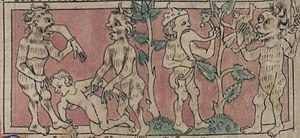Content and influence
Gates of Alexander
The late antique Christian Syriac Alexander Legend transformed the Gates of Alexander into an apocalyptic barrier built by Alexander in the Caucasus to keep out the nations of Gog and Magog.[9] This development was inspired by some elements of the historical context of the time, including dread of the northern hordes, a variety of Persian fortifications meant to seal off the movement of steppe nomads, and eschatological thinking and attitudes of the time.[10] At its outset, the Syriac Alexander Legend (otherwise known as the Neshana) records Alexander constructing a wall of iron to prevent an invasion of the Huns that would result in the plunder of peoples and countries. Alexander commanded that the gate should be constructed out of iron and bronze, for which he recruited three thousand blacksmiths to work the latter and three thousand other men for the former. However, it was believed that the barbarian tribes would break through during the apocalypse.[11] The dimensions and features of the gate are described in detail, and Alexander was said to have placed an inscription on it which reads "The Huns will come forth and subdue the countries of the Romans and Persians; they will shoot arrows with armagest and will return and enter their country. Moreover, I wrote that (at) the end of eight hundred and twenty six years, the Huns would come forth by the narrow road..." (the inscription goes on for several more pages). This prophecy whereby the Huns break through the gates is linked to the invasion of the Sabir people in 515 AD as Syriac texts would use the Seleucid calendrical system which began in 1 October, 312 BCE; by subtracting 311 or 312, a date of 514/5 is arrived at, representing a vaticinium ex eventu. A second prophecy of an incursion appears for 940 SE, pinpointing to 628/9 AD and corresponds with the invasion of Armenia by the Turkic Khazars (not to be confused with a reference to the Turks which may not occur in this type of literature until the ninth century),[10] although this may have been an interpolation that was made into the text during the reign of Heraclius to update the narrative for a contemporary political situation.[12]
The description of the gates of Alexander in the Syriac Alexander Legend influenced most subsequent Syriac literature describing these events.[13]
Gog and Magog

The Legend is considered the first work to connect the Alexander Gates with the idea that Gog and Magog are destined to play a role in the apocalypse.[14] In the Legend, Gog (Syriac: ܓܘܓ, gwg) and Magog (Syriac: ܡܓܘܓܵ, mgwg) appear as kings of Hunnish nations.[a][15] The legend claims that Alexander carved prophecies on the face of the Gate, marking a date for when these Huns, consisting of 24 nations, will breach the Gate and subjugate the greater part of the world.[b][16][17]
The Gog and Magog material, which passed into a lost Arabic version,[18] and the Ethiopic and later Oriental versions of the Alexander Romance.[19][c] It has also been found to closely resemble the story of Dhu al-Qarnayn in the Qur'an (see: Alexander the Great in the Quran).
The Pseudo-Methodius, written originally in Syriac, is considered the source of the Gog and Magog tale incorporated into Western versions of the Alexander Romance.[20][21] The Pseudo-Methodius (7th century[22]) is the first source in the Christian tradition for a new element: two mountains moving together to narrow the corridor, which was then sealed with a gate against Gog and Magog. This idea is also in the Quran (609–632 CE[23][24]), and found its way in the Western Alexander Romance.[25]
Western Alexander romances
This Gog and Magog legend is not found in earlier versions of the Alexander Romance of Pseudo-Callisthenes, whose oldest manuscript dates to the 3rd century,[d] but an interpolation into recensions around the 8th century.[e][27] In the latest and longest Greek version[f] are described the Unclean Nations, which include the Goth and Magoth as their kings, and whose people engage in the habit of eating worms, dogs, human cadavers and fetuses.[28] They were allied to Belsyrians (Bebrykes,[29] of Bithynia in modern-day North Turkey), and sealed beyond the "Breasts of the North", a pair of mountains fifty days' march away towards the north.[g][28]
Gog and Magog appear in somewhat later Old French versions of the romance.[h][30] In the verse Roman d'Alexandre, Branch III, of Lambert le Tort (c. 1170), Gog and Magog ("Gos et Margos", "Got et Margot") were vassals to Porus, king of India, providing an auxiliary force of 400,000 men.[i] Routed by Alexander, they escaped through a defile in the mountains of Tus (or Turs),[j] and were sealed by the wall erected there, to last until the advent of the Antichrist.[k][31][32] Branch IV of the poetic cycle tells that the task of guarding Gog and Magog, as well as the rule of Syria and Persia was assigned to Antigonus, one of Alexander's successors.[33]
Dhu al-Qarnayn
|
Main article: Theories about Alexander the Great in the Quran |
In the late 19th century, Theodor Noldeke proposed that traditions of the Syriac Alexander Legend played a role in the formation of traditions about an enigmatic figure named Dhu al-Qarnayn ("The Two-Horned One") in the Quran. Forgotten, this thesis would be revived by Kevin van Bladel in a 2008 article.[34] Since then, the thesis has been further developed by publications from Tommaso Tesei.[35][8] Some of the main combination of motifs that have been related between the two texts involve an apocalyptic incursion, Gog and Magog, and Alexanders gates. More specifically, representations of a gate built by the protagonist (Alexander and Dhu al-Qarnayn) from iron and bronze components between two mountains in order to seal away a barbarian tribe equated or related to Gog and Magog, only for the barrier to be broken through during the apocalypse to unleash the end of the world prior to the ultimate judgement.[36]